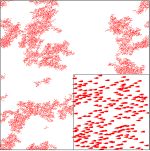EPJ B Highlight - Swarm intelligence
- Details
- Published on 27 March 2013

A new study of animal swarms uncovers some new features of their collective behaviour when overcrowding sets in
Swarming is the spontaneous organised motion of a large number of individuals. It is observed at all scales, from bacterial colonies, slime moulds and groups of insects to shoals of fish, flocks of birds and animal herds. Now physicists Maksym Romenskyy and Vladimir Lobaskin from University College Dublin, Ireland, have uncovered new collective properties of swarm dynamics in a study just published in EPJ B. Ultimately, this could be used to control swarms of animals, robots, or human crowds by applying signals capable of emulating the underlying interaction of individuals within the swarm, which could lead to predicted motion patterns elucidated through modelling.
The authors were inspired by condensed matter models, used for example in the study of magnetism, which were subsequently adapted to be biologically relevant to animal swarms. In their model, in addition to the ability to align with its neighbours, each model animal is endowed with two new features: one for collision avoidance and another preventing direction change at every step to ensure persistence of motion. The team performed computer simulations of up to 100,000 self-propelled particles, each mimicking an individual animal and moving at a constant speed on a plane surface.
They found that when the swarm becomes overcrowded, the globally ordered motion breaks down. At high density and when the nearest neighbours are within one step of each other, each animal can no longer decide on the safe direction of motion. Instead, it is busy correcting its motion to avoid collisions.
They also described, for the first time, a power law that quantifies the average degree of alignment in the direction of motion for animals within the swarm. The law describes how the alignment decays from the centre of the swarm, where animals can best judge the swarm motion due to their maximum number of neighbours, to the periphery.
M. Romenskyy and V. Lobaskin (2013), Statistical properties of swarms of self-propelled particles with repulsions across the order-disorder transition, European Physical Journal B, DOI: 10.1140/epjb/e2013-30821-1




